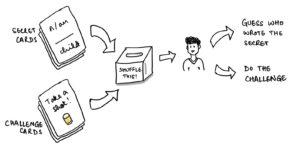I played a new, yet-unnamed board game in the social, “getting to know people” genre. The game can be played with 4+ players and begins with each player writing down a secret or fact about themselves on an index card. Additionally, there is a set of cards with challenges written on them. All cards are put in a box, from where each player randomly draws a card on their turn. If the drawn card is a challenge card, they should complete the challenge. If it is a secret card, the player then attempts to identify the player who wrote the card, i.e. who the secret is about. If they guess correctly, they replace the card with a challenge card that is either drawn from a set of pre-written cards, or a new challenge written by them; if they guess incorrectly, they put the secret card back into the box, draw a challenge card from the pre-written card set, and should complete the challenge. The flow is shown in the diagram below.

A mixture between a drinking game and an icebreaker game, this game delivers primarily on the fellowship aesthetic, alongside a bit of challenge. The social interaction element differentiates it from other drinking games; in terms of other icebreaker games, the differentiation is a bit slim, since other games like Who Is It? have the same social element, but the addition of challenges makes the game more fun by adding some stakes. Additionally, by allowing players to come up with their own challenges, it adds elements of creativity and humour.
In the current form, the index cards were simply pieces of paper, which meant that the size of the paper or the kinds of folds on them could lead to hints about who wrote a card. Additionally, how well the group knows each other is a very important piece of how fun the game ends up being. If people are barely acquaintances, guessing who wrote a secret becomes extremely difficult and the game can get repetitive since the same secret card may get drawn multiple times without being correctly associated with the author. On the other hand, if people know each other very well, it becomes trivial. Small groups within the player group who know each other better than others can also skew the game a bit. For instance, if a secret card stating “I was born in Kansas” gets drawn, anyone who knows the birthplace of another player (the author or any other player) has an advantage over others.
A digital version of the game would remove physical variables such as the shapes/sizes of index cards, the color of ink a player uses, or somebody’s handwriting. Additionally, during our play round, the same secret and challenge cards got drawn around three times. While this was fun for the particular challenge card we had, it felt quite repetitive for the secret card. It is likely that a random challenge card would also be best used only once. So, limiting the number of times a card can be drawn, say to one by not putting any card drawn back into the box, could lead to a more interesting playing experience.



